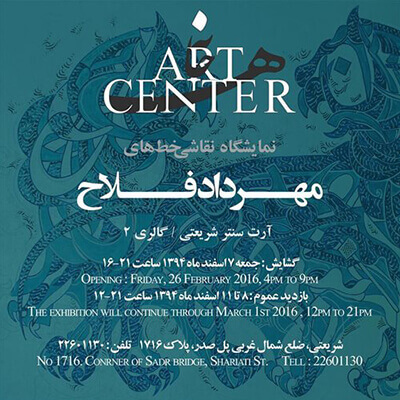Solo Exhibitions

Lion with Line
2017 Farda Gallery
By Sadegh Tabrizi
In the Iranian culture and other nations, the lion has been introduced as a symbol of power, courage, fairness, justice, tolerance and many other great qualities.
The difference in Fallah’s themes with the ancient motifs evokes memories of his presence in the distant past and from the heart of history. Memories engraved in thought beyond history, such as the unlucky lion, Nadali’s lions, Fadh’s lion, and the lion in the path of the Prophet, and in the ascension and finally the lions of Ali, all and all in the artist’s novels. His world full of lion introduces him.
In Iranian mythology, the lion is a symbol of masculinity, courage and power. For this reason, the pious Mawlawi (AS) is attributed to the lion of God, and also the warrior and warrior men are known as the lion of men, just as the skilled hunter is called the lion of prey.
For centuries lion had hoisted the flag of this land. With the combination that the sun rises and shines from its pollen and the sword fights at hands.

Rooster – Duet Exhibition
2017 Farda Gallery
Relining on animals as mythological allegories have had a long high status in Iranian art, beside many animals in paradise were adjacent to humans and continued to coexist after humans landed on earth.
These animals have a sacred place and status, as many prophets have maintained this relationship with animals, and as well artists have tried to continue it and have used the animal behavior as myths and allegories in educational literature. Book stories such as Kelileh& Demneh and MarzbanNameh plus many other Persian literature masterpieces are a clear example of this continuity.
The rooster is an animal that has been trained and lived with humans. In parables, the rooster is widely used. The rooster’s crow is a symbol of awareness and awakening. The accompaniment of this cry with the rising of the sun gives a mythological value to the rooster because the sun itself has a sacred place in Persian myths. Visual function of painter roosters in combination with line and
The calligraphic form has inter-text references to science, wisdom and awakening, and the artist tries to represent this form the perspective of prominent modernist and neo-traditionalist artists. Shows the use of decorative visual elements along with colorful and bright colors in some of the artist’s evolving works to search in this valley.
In some of these collections, the works of the birds themselves are a symbol that evokes a mystical context; As Simorgh in the stories of Attar and Shahnameh is a combination of thirty birds and the phenomenon of the wisdom of movement and collective transcendence.

Calligraphy
2015 Art Center
Saqakhaneh School: A fire which did not turn off
By Reza Baraheni
In Fallah’s works, there are obvious signs of the re-emergence of Saqakhaneh school. The point which prompted me to write about his art work was the sings that captured my eyes in which he presented a new step and perspective in his works. The Nadali linos that we have seen in spells and armbands, have now raised and showed in canvases. In Fallah’s work, which has led us to kind of Dadaism in Saqqakhaneh School, he reveals the vague and incomprehensible signs in the manuscript prayers which are hidden in front of the myths, and present them in the form of pop art.
Sending photos of these works represents a great opportunity to get acquainted with one of the new phenomena in line of this school that shows a desirable influence of the works of the forties. As you can see, these images are obtained with insufficient computer capabilities It seems that Fallah’s works have a strong and experienced technique and we hope that his works will open a new section in the strategies of the Saqakhaneh School, since the rich treasure of Iranian art which was the source of inspiration for the school’s leaders will always open a new way for the Iranian artists.